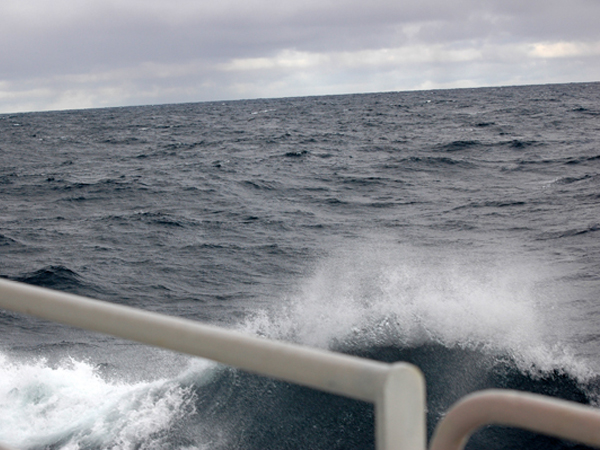
On our second full day at sea, the RUSALCA team encountered swells of about 6 to 8 feet. Compounding seasickness, the ship had to "sit" sideways to the waves at times to deploy scientific instruments, in a position known as "wallowing in the trough." Click image for larger view and image credit.
The Motion of the Ocean and Its Discontents
September 10, 2009
Christine Patrick
Public Affairs Specialist
NOAA's Office of Ocean Exploration and Research
For over a day, we have been plowing through estimated 6- to 8-foot swell in the Chukchi Sea. Heading into it has meant the ship has cut its speed to about 6 knots (nautical miles per hour). It has also meant that a number of people have felt the effects of seasickness, myself among them.
Over the last day, being anything but horizontal for even 30 minutes causes me increasing nausea. Yet as miserable as I feel, I’m actually very lucky. The science teams need to do their work when they get to the next station, whatever time that may be and however seasick they may feel. Last night, we got to a station around midnight, and the science teams were collecting samples in darkness (save the lights of the ship) through about 6 a.m. During this 30-day mission, they aim to sample over 100 stations.
Five different sets of equipment — ranging from water samplers to sediment samplers and nets — are deployed at most stations. There is also a Russian remotely operated vehicle (ROV) to image the bottom and a long core sampler; both of these have been deployed just a few times so far. The samples gathered by all the equipment and instrumentation may be used for several purposes, since some science teams share a sample but conduct different tests on it. Forthcoming scientists’ logs will help explain these gears, instruments, samples, and experiments.
To deploy some instruments, the ship turns parallel to the swell — what’s known as “wallowing in the trough.” The ship rolls differently when oriented this way, actually making nausea worse for both those on deck and those wallowing in their own cabins. This ship is already more rolly than others; ice-strengthening the hull means losing some of the stabilizing features other ships have. “Be carefully,” our Russian captain has reminded us.
It has been five years since the last RUSALCA mission, and many of the same scientists are back to retest some of the same locations as last time and compare the results. They are prepared to get up in the middle of the night, if that’s when we reach a station, and to work for several hours. Although many report that being outside and concentrating on their work makes seasickness recede, they have been known to lean over the side to be sick. Most people get over seasickness with time, but I hear rumors of people whose bodies simply don’t get used to the movement of the ship.
Seasickness medicine can lessen nausea for most people, but paradoxically, works best if you take it before you feel seasick. Since the medicine itself has negative effects, primarily drowsiness, whether to take it at all remains a question, particularly for those who need to be alert at a station. Whether to eat or not is also a question, since everyone’s body acclimates differently to living on the sea. Staying hydrated, lying down, breathing fresh air outside and staring at the horizon are, however, time-tested aids for seasickness. I can only hope these methods work, and that calmer, icier waters are ahead.















